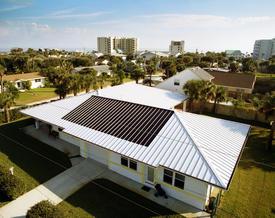When discussing house designs, most of the energy design specialists will point out how they are designing homes so that they are more energy efficient by requiring less energy to keep the homes warm. However for those homeowners who live in southern climates, energy savings is relative to cooling costs, not heating costs.

Figure 1 - Plantation home
Designing homes to be cool was a common practice in the South. The hot climate plantation homes, as shown in Figure 1, are prime examples of house construction in hot climates. However, the concept of designing a house to be naturally cool was lost, probably because of the advent of central air conditioning and cheap energy. And, even though energy is no longer cheap, very few builders and architects have changed the basic southern home design.
Homes that are constructed in geographic areas where the cost of cooling is higher than the cost of heating should be designing homes that create a barrier, deflect or create shadow protection to heat on the exterior of the home.
There are three keys to designing homes for hot climates.
- House designers often talk about the “delta-T” of the geographic area of where a property is being constructed. The higher the delta-T the more difficult it is to construct a home that is comfortable year round and at the same time is energy efficient. The delta-T is the difference between the exterior and interior temperatures. In the Northern part of the U.S., some homes can face outdoor temperatures well into the minus temperatures. If a home is 70 degrees Fahrenheit in its interior and -40 degrees Fahrenheit on its exterior the delta-T would be 110 degrees Fahrenheit. In the Southern U.S., it is more likely to face delta-T swings of 40 or 50 degrees Fahrenheit.
- A home’s air leakage is as critical if not more critical in the south than in the north. The more air leakage that a home experiences, the harder the air conditioning must work to dehumidify and removing the humidity is a key to comfortable living, as it is high humidity levels that are more uncomfortable than high heat. A house with low air leakage will be easier to dehumidify and hence be a more comfortable home to live in.
- The placement of windows in a southern home can have a much more detrimental effect on cooling than in a northern home. Large windows that face west should be avoided, however if they are required, by design, they must be properly glazed in order to avoid high levels of heat gain.
With a lower delta-T it is possible to reduce the R-factor of insulation in floors and walls.
Best Hot Climate Building Practices
Although builders do not seem to pay much if any attention to good building practices in southern climates, a lot of money has been invested, into best practice construction in southern climates, by numerous research institutes throughout the U.S. In many cases these practices would have a minimal effect on the overall construction cost of the home.
An overview and summary of some of the best hot climate building practices follow:
- Where developers are building sub-divisions, the individual properties should be laid out so that the orientation of the homes allow for the longest dimension to be on an east-west axis.
- The use of cupolas can provide natural ventilation at the highest point of the home and were a very common architectural feature on plantation homes.
- Where homes are designed with concrete slab foundations, the slab should not have insulation below it. As the earth is generally colder than the air, the concrete slab can become a heat sink for the hotter temperature in the home.
- The settlers who went south built their homes with large eves, to provide shade to the windows and rooms. In some cases these overhangs, which became porches and balconies around the home, were as wide as 10 feet. While a 10 foot balcony or porch, running around the outside of your home might be nice, in many cases the land requirement is not available to consider this type of construction, a 3 to 4 foot overhang should provide the needed window shading, as shown in Figure 2.
This provides the minimum square foot area of wall that will absorb the sun’s heat. It should also mean that the majority of window glass will face north and south rather than east and west. This will also reduce the home’s heat gain.

Figure 2 - Home designed for southern climates
- A common mistake made by builders and architects is to place the air conditioning ducting outside of the insulated house space, by placing them above the ceiling’s insulation in the attic. This means that the cold air in the ducts must travel through hot duct work. If duct work is located in the attic, then the ceiling of the attic should be insulated to a level of at least R-30.
- The roof is the biggest exposed area for solar heat gain. Anything that reduces the roof heat gain is advantageous in a southern climate. Using white roofing that has a reflective quality will make a substantial difference. White metal roofing, as shown in Figure 2, suits the purpose extremely well as does white concrete tile.
- While wall insulation is important in southern climates it is not as critical as it is in northern climates. A level of R-10 for walls will suffice (a higher R value is not a negative.
- The solar heat gain of windows is critical in a home constructed in a southern climate. When purchasing windows, specify a solar heat-gain coefficient of 0.28 to 0.29. The maximum solar heat-gain coefficient should 0.32.
Hence, the style of roof becomes an important part of the hot climate design criteria. A hipped roof, as shown in Figure 2, will shade all sides of the home, where as a gable roof would only shade two sides.
Additional information on roof styles
If having a home with a large eve is not aesthetically pleasing, you can also consider shading the windows by recessing them into the walls and/or using awnings or other design features to provide shading.
Even with R-30 insulation it is wise to use roof sheathing that has an integral radiant barrier.
Additional information on metal roofing
In northern climates the wall insulation is usually placed on the interior side of the house structure. However, where concrete block construction is used in southern climates the insulation should be placed on the exterior side of the wall. This prevents the concrete blocks from heating up and acting like a brick oven that encases the home.
It should be noted that a great deal of inadvertent heat gain can come from lighting and appliances inside the home. In hot climate regions this heat gain can be quite noticeable and the homeowner should ensure that all lighting is either LED or CFL technology. All appliances should be highly efficient. On-demand or tankless hot water systems have less heat loss within the home compared to tank style water systems.
For many reasons, including keeping a southern home more comfortable, ceramic, porcelain or natural stone tile is the recommended finish flooring material.
